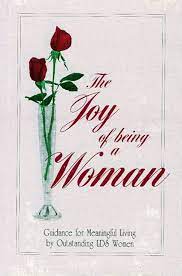Articles/Essays – Volume 08, No. 2
The Many Phases of Eve | Duane S. Crowther and Jean D. Crowther, eds., The Joy of Being a Woman, and Wayne J. Anderson, Alone but not Lonely
The Joy of Being a Woman, a feminine companion to Win If You Will by Paul H. Dunn, could undoubtedly be used for illustrating talks and Relief Society lessons dutifully woven to bind sisters tightly into patterns of acceptable behavior.
The Crowther team has created a compilation of feminine self-reports. Their goal was to present “the wisdom and values of outstanding Latter-day Saint women concerning woman’s role in the modern world.” But this objective was diluted when the contributors were invited to write something “useful, . . . suggestions concerning things which had worked well for them.” Unfortunately the contributions are mostly useful. When glimpses of wisdom and values appear, they are only appetizers teasing the reader with a desire to engage in conversation uninhibited by oversimplification.
Obviously this book is in part the reaction to much current talk regarding “the place” of women, a legitimate concern for men and women. Discussions on this subject suggest that we are in the process of evolving higher levels of individual and social integration. But before a new level is reached there is necessarily a trying period of positive disintegration, which breaks down the old system of ineffectual approaches. Void of this kind of understanding, The Joy of Being A Woman often idealizes and stultifies female roles instead of analyzing and elevating them to more mature heights. One example in this regard is the beauty queen syndrome.
Most of the twenty-three women included in the anthology are either from or now living in Utah. This encourages a traditionalism that many raised outside the state find shocking, for the Utah culture often discourages women from achieving the kind of joy that results from using one’s mind, spirit and body as an integrated whole with no apologies, no defined limitations. One woman, Laraine Day, risked hinting at this when she stated, “I have long felt that one of the greatest weaknesses of the membership of our Church has been its habit of gathering together to the exclusion of meaningful social contact and association with other people not of our faith.”
These twenty-three women speak of their roles in very traditional ways, but fortunately many of them behave in uncommon ways. Examples are Elaine Cannon, Virginia Cutler, Laraine Day, Ettie Lee, Jackie Nokes, and Lenore Romney. Their actions speak louder than words, and these uncommon actions serve as the greatest source of inspiration. Hopefully our cultural reward systems will one day allow actions and words to become united.
Alone But Not Lonely contains “thoughts for the single, widowed, or divorced woman.” According to the Foreword, this book is the natural result of Dr. Anderson’s counseling experiences with “hundreds of single women, who have repeatedly asked, ‘When are you going to put the things we have talked about into book form?'” There are some who might wish that such books about the lives and experiences of Mormon women would be written by women. Has our traditional conditioning under the Patriarchal order led us to always expect men to speak for women? Those given to Freudian interpretations might see this book as an example of a man giving rebirth to women in order to balance the scales for his having been born of woman.
Alone is painfully basic in its step-by-step approach to the concerns of those who find themselves in a Mormon environment, which values coupling to the point of excluding, in a very un-Christian way, those who are single for one rea son or another. The book does have one redeeming chapter, “Information About Divorce Procedures,” which demonstrates an acknowledgment that human people, who might also be Latter-day Saints, do in fact get divorces.
Providing “proven guidelines for more confident living” begs the issues. One does not tell others how to live in order to lead them to greater happiness; a higher principle encourages the teaching of principles and then leaving it up to individuals to discover their own approach to life. The bromides of “Guides to Confident Living” might well have been omitted.
The superficial skipping through problems of singlehood, without considering some of the positive experience of singleness, makes one wonder if the author has only heard what it is like to be alone but never truly empathized with or experienced the agonies and the ecstacies. It would have been more rewarding to have had more explicit reports from individual women. Alone But Not Lonely serves as a satisfactory primer, but one who is single would do well to move on to Moustakas’ investigation of loneliness, Buber’s examination of I-Thou relationships, and Maslow’s freeing suggestions about self-actualization.
The existence of both of the books reviewed here re-emphasizes the need of enlightened Mormon women to define the divine within them. They should stop consenting to the attitudes of men, cultures, and traditions that have little to do with the fact that they were created in the image of their Mother in Heaven. Women will be punished for their own sins and not Eve’s transgressions.
The Joy of Being a Woman. Compiled and Edited by Duane S. Crowther and Jean D. Crowther. Salt Lake City: Horizon Publishers, 1972. 326 pp. $4.95.
Alone but not Lonely. By Wayne J. Anderson, Ph.D. Salt Lake City: Deseret Book Company, 1973. 156 pp. $3.95.


 Back to full Issue
Back to full Issue

